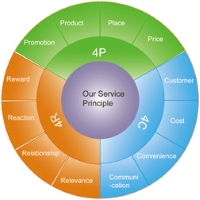In the 1960s, international marketers developed what they considered the perfect formula for business: the "4P Theory" or "Marketing Mix." According to this theory, success can be achieved by focusing on the 4Ps: Product, Price, Promotion, Place. In simple terms, if you produce the right product at the right price, sell it in the right place, and advertise it effectively, you'll never run out of clients.
Until the mid-1990s, the 4P concept (with some refinements) was promoted in all economics textbooks as a universal remedy for entrepreneurial challenges. However, later market researchers proposed a different approach, labeled "4C": Consumer, Cost, Convenience, Communication.
What's the Difference Between 4P and 4C Marketing?
The key difference lies in the focus: the 4P model prioritizes product attributes and market promotion, while the 4C model emphasizes the needs of the end consumer.
Let's illustrate these differences with an example.
Imagine you decide to open a household goods store. The 4P approach suggests you research competitors, select the right product range, and advertise your goods. Naturally, you'd place your stall selling light bulbs not in a luxurious mall but near residential areas, as most people think of buying soap or matches on their way home, not during a leisurely outing.
All seems fine. But what did you overlook? You missed the fact that most of your clients will be one-time customers, with no motivation to return.
How to Turn Buyers into Loyal Customers
To gain loyal customers, you need to expand your efforts. For instance:
- Hire marketers to craft an effective advertising campaign.
- Use outdoor advertising and mass media promotions.
- Many Ukrainians still read newspapers and watch TV, so don't dismiss these traditional methods.
- Create a community on social media to inform subscribers about new trends and promotions.
- Consider an online feedback or suggestions form, or even an online store—why limit yourself geographically?
- Leverage mobile marketing and SMS mailings.
- Participate in forums and trade exhibitions. This helps you stay updated on trends and boosts brand awareness among industry peers.
Of course, these strategies may not directly apply to a modest kiosk selling household items. However, the rules of the market are universal, and these are elements of the 4C concept.
Ukrainian entrepreneurs must also consider that many locals are not accustomed to electronic payments or online shopping. Focus should therefore remain on offline promotion. People prefer to see, touch, and evaluate products before buying.
Incorporate advertisements that encourage user interaction: "Come and try it!" For instance, urban cafes actively use services like Foursquare ("Check in at our location and get a bonus") and mobile marketing ("Show this message and get a free coffee"). Sending an SMS to a loyal client database is one of the simplest and fastest ways to remind them of your business.
That said, while advertising campaigns, loyalty programs, and robust communication channels can draw people to your business, only high-quality, competitive products (or services) will keep them coming back. Therefore, it's better to combine the 4C and 4P approaches rather than rigidly adhering to one. After all, Ukraine has moved beyond the era of "the more, the better."
Understand your consumers and stay one step ahead—they will appreciate it!





